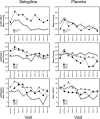Response to Transdermal Selegiline Smoking Cessation Therapy and Markers in the 15q24 Chromosomal Region
- PMID: 25572450
- PMCID: PMC4627483
- DOI: 10.1093/ntr/ntu273
Response to Transdermal Selegiline Smoking Cessation Therapy and Markers in the 15q24 Chromosomal Region
Abstract
Introduction: Current treatments for smoking cessation have limited efficacy. A potential pharmaceutical treatment for smoking cessation is selegiline, a selective and irreversible monoamine oxidase B inhibitor. A few clinical trials have been carried out using selegiline but the results have been mixed. We sought to determine if genetic markers in cholinergic loci in the 15q24 chromosomal region predict response to smoking cessation therapy with selegiline.
Methods: We performed an 8-week double-blind, placebo-controlled clinical trial of the selegiline transdermal system in heavy smokers, with follow-up at weeks 25 and 52. Eight single nucleotide polymorphisms (SNPs) in the 15q24 region, which contains the genes for the nicotinic acetylcholine receptor subunits CHRNA5, CHRNA3, and CHRNB4, were investigated for association with treatment response.
Results: The CHRNB4 promoter SNP rs3813567 was associated with both point prevalence abstinence and post-quit craving. Carriers of the minor C allele treated with selegiline showed lower rates of abstinence and higher levels of craving than selegiline-treated non-carriers, indicating that the rs3813567 C allele adversely affects abstinence in selegiline-treated smokers. This effect was not present among placebo-treated smokers. Selegiline-treated smokers with the CHRNA5 rs680244 GG genotype had lower post-quit craving, and unlike placebo-treated GG-carrying smokers, did not experience a post-quit increase in depressive symptoms.
Conclusions: Variants in genes encoding cholinergic receptors affect abstinence, craving and mood in selegiline-treated smokers. Selegiline primarily affects dopamine levels in the brain, but cholinergic input affects nicotine-induced dopaminergic activity. These markers may have value in identifying those likely to respond to selegiline for smoking cessation.
© The Author 2015. Published by Oxford University Press on behalf of the Society for Research on Nicotine and Tobacco. All rights reserved. For permissions, please e-mail: journals.permissions@oup.com.
Figures


References
-
- Syamial G, Mazurek JM, Malarcher A. Current cigarette smoking prevalence among working adults—United States, 2004–2010. MMWR. 2011;60:1305–1309. - PubMed
-
- Adhikari B, Kahende J, Malarcher A, Pechacek T, Tong V. Smoking-attributable mortality, years of potential life lost, and productivity losses—United States, 2000–2004. MMWR. 2008;57:3. - PubMed
-
- Magyar K. The pharmacology of selegiline. Int Rev Neurobiol. 2011;100:65–84. - PubMed
-
- Lamensdorf I, Youdim MB, Finberg JP. Effect of long-term treatment with selective monoamine oxidase A and B inhibitors on dopamine release from rat striatum in vivo. J Neurochem. 1996;67:1532–1539. - PubMed
Publication types
MeSH terms
Substances
Grants and funding
LinkOut - more resources
Full Text Sources
Other Literature Sources
Medical

